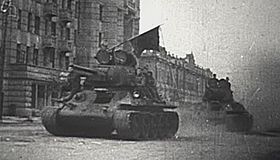Orel Strategic Counter-offensive Operation
| Operation Kutuzov | |||||||
|---|---|---|---|---|---|---|---|
| Part of the Eastern Front of World War II | |||||||
 Soviet T-34 tanks enter Orel, 1943 |
|||||||
|
|||||||
| Belligerents | |||||||
|
|
|
||||||
| Commanders and leaders | |||||||
|
|
|
||||||
| Strength | |||||||
| 300,700 men 625 tanks and assault guns 610 aircraft 5,500 guns |
1,286,000 men 2,409 tanks and assault guns 2,220–3,023 aircraft 26,379 guns |
||||||
| Casualties and losses | |||||||
|
86,454 men
unknown guns 218 aircraft |
429,890 men
892 guns lost 1,014 aircraft destroyed |
||||||
86,454 men
429,890 men
Operation Kutuzov was the first of the two counteroffensives launched by the Red Army as part of the Kursk Strategic Offensive Operation. It commenced on 12 July 1943, in the Central Russian Upland, against Army Group Center of the German Wehrmacht. The operation was named after General Mikhail Kutuzov, the Russian general credited with saving Russia from Napoleon during the French invasion of Russia in 1812. Operation Kutuzov was one of two large-scale Soviet operations launched as counteroffensives against Operation Citadel. The Operation began on 12 July and ended on 18 August 1943 with the capture of Orel and collapse of the Orel bulge.
As the end of the rasputitsa or rainy season approached, the Soviet command considered their next steps. Stalin strongly desired to seize the initiative and attack the German forces but was convinced by his senior commanders to take an initial defensive posture and allow the Germans to weaken themselves in attacking prepared positions. After this the Soviet forces would go over onto the offensive. Operation Kutusov was the offensive plan for the Soviet forces before Moscow facing the German forces of Army Group Center. It was carried out by three Soviet Fronts or army groups: the Western Front, the Bryansk Front and the Central Front. The offensive was directed north of the Kursk area against the German 2nd Panzer Army, with the intention of cutting behind and trapping the German 9th Army then conducting offensive operations against the Kursk salient.
The Germans had spread their forces thin all across the front in an effort to provide as much men and material as possible for Operation Citadel. Holding the front before the Soviet offensive were the 2nd Panzer Army and elements of the 9th Army. The region had been held by German forces for nearly two years and despite Hitler's admonition not to build defensive works behind the front, some preparations had been made. A defensive line had been started that was 5–7 kilometres (3.1–4.3 mi) in depth, consisting of minefields, interconnected trench works, and strong points. Wherever possible, the Germans took advantage of terrain features such as streams, ravines and gullies but the positions were thinly held.
...
Wikipedia
